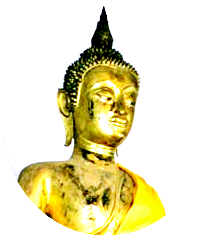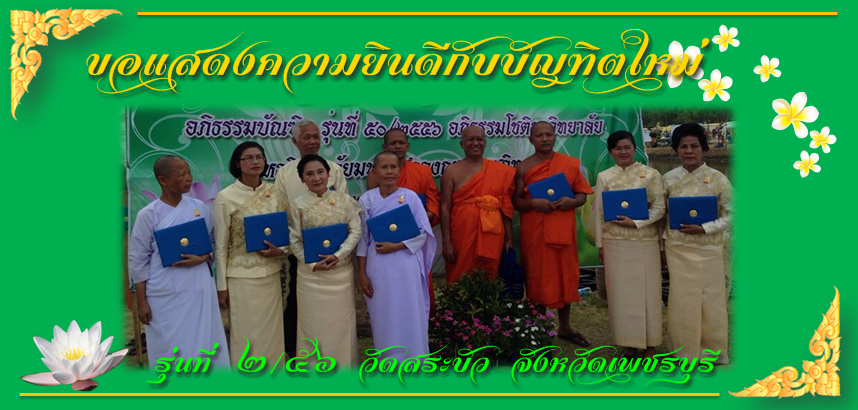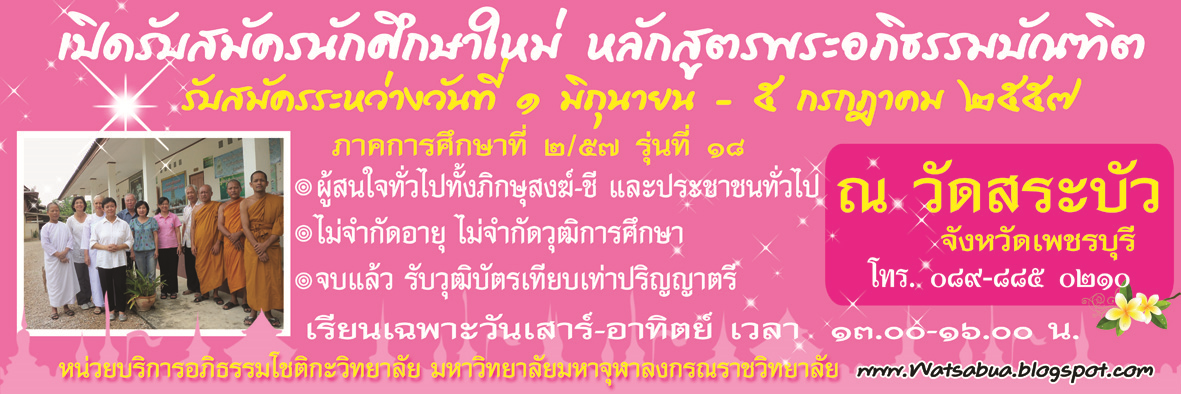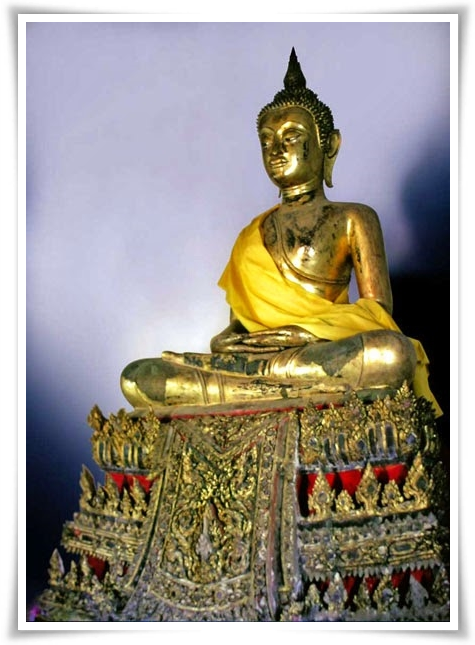A case of
comparative study of
Bhavanga-citta, subsconcious mind, in Buddhism and western philosophy.
By Dr. Phramaha
Thotsaporn Iddhivaro
Buddhist Faculty, MCU.
Bangkok, Thailand.
Preface
I am invite to write this article to
show in international research seminar in January 2011. This seminar is held by
Buddhist research institute at Mahachulalongkorn Buddhist University. This
seminar draws scholars from inside and
outside Thailand to express their ideas.
Bhavanga-citta,subconscious
mind is the article I would like to express, inside and outside Buddhism.
Buddhism is religion we follow and practice. Sometime Buddhism is considered as
philosophy. Outside Buddhism means Sigmund Freud. He is a famous psychologist
in the western world.
Sometime Buddhism is
religion. Sometime Buddhism is philosophy. Both ideas are correct according to
their perspective.
The topic I would like
to express to all of you who come to this event is a case of comparative study
about Bhavanga-citta, subconscoious mind, in Buddhism and western philosophy.
It seems for me to
difficult for people who don’t understand Abhidhamma, Buddhist philosophy to
understand this case. Even though Abhidhamma, Buddhist philosophy, is a core of
Buddhism, but Buddhist people have less understanding about that Abhidhamm.
.Bhavanga-citta,
subconscious mind, is the most important citta in Abhidhmma because people come
to this world, stay in this world, apart from this world with this
Bhavanga-citta.
In my comparative study, I would
like readers to understand Bhavang-citta in Abhidhamma first and citta in
Sigmund Freud later. Readers would understand Abhidhamma more than before. I hope
so.
Dr. Phramah Thotsaporn
Iddhivaro
10 January 2011
Contents
- What is citta
- What is a number of citta
- What is function of citta
- What is operation of citta
- What is Bhavanga-citta.
- What is citta in Sigmund
Frued.
- Conclusion
What is citta.
Citta, mind, is Pali word in Theravada
Buddhism. There 10 kinds of synonym for citta[1], mind. They are:
1. Citta means to think the objects.
2. mano means to go forward to the objects.
3. Hadya means to collect the objects.
4. Manas means to satisfy the objects.
5. Bandhara means to be pure.
6. Manayatana means to connect the objects.
7. Manitdhriya means to prominent the objects.
8. Vinyana means to know the objects
9. Vinyana Khantha menas to be a group.
10.
Vinyanadhatu
means to keep its status.
Citta
knows objects by eyes, ears, noses, tongue, body and by itself. There are six
objects; color, sound, smell, taste, tangible and mental objects. In
Atthasalinee stated that eyes like a snake, ears like a crocodile, noses like a
bird, tongue like a fox, body like a dog, mind like a monkey. Citta exits
depending on six objects eventually. This is citta-niyama, mind-order.
[1]
Kuddhakanikaya, Mahanidesa, Volume 29, 3
What is a number of citta
Citta is divided into four kinds[1]. They are akusa-citta, unwholesome citta,
kusala-citta, wholesome citta, vipaka-citta, resultant citta,
and kiriya-citta, functional-citta.
Akusala- citta means mind does not cut
bad thing which happens through physical, verbal and mental actions. People who
commit themselves to akusal-citta think bad thing, speak bad thing, and act bad
thing. Akusala-citta produces bad thoughts, bad speech, and bad action.
According
to Buddhist teachings, akusala-citta has three roots to back up. They are greed, hate, and
delusion. Greed makes people to break precepts like a killing. Hate makes
people to break precepts like a stealing. Delusion makes people break all
precepts. People who eliminate precepts earn akusala-citta.
People who eliminate precepts receive bad fruit from their
action. They see bad sight, hear bad sound, take bad smelling ,
take bad taste, touch bad tangible and take bad mental objects
in daily life. They do not wait until they die and go to hell.
There are 12 of unwholesome[2]. They are 8 of greediness of consciousness, 2 of hate
of consciousness, and 2 of delusion of consciousness . Greediness takes people
who commit evil into hungry ghosts. Hate
takes people who commit evil into hell.. Delusion takes people who commit evil into
animal realm. Twelve of unwholesome produce bad fruit in both this life and
next life.
Those of Greediness are divided into eight of
mind. Greediness of mind consists of 3 factors of bad mental properties. They
are greediness, wrong views, and conceit. Mind comes up with 3 bad mental properties
ends up with bad results through 5 sense doors and mind door in this present
live. After they are dead, they go to hungry ghost. There are 3 of greediness.
The first one is greediness of sexual desires. The second one is greediness with
assets. The third one is greediness of pride. There are 2 of wrong views. The
first one is sassada-ditthi, eternalism. The second is uccheda-ditthi,
annihilationism. People who commit in eternalism believe that they stay for
ever. People who commit in annihilationism believe that they expire after this
life.
Those
of hate are divided into 2 of mind. Hate of mind consists of bad mental properties.
They are angriness, envy, stringiness, and worry. Mind comes up with 4 bad
mental properties end up with bad result through 5 sense doors and mind door in
this present live. After they are dead, they go to hell.
Delusion
is a core of unwholesome. When unwholesome takes place, this delusion exits
eventually. It produces all bad things
in mundane world
In
general, greediness, wrong view, and delusion are play a big role for
unwholesome. Greediness and wrong view don’t come up all the times but delusion
take place when mental properties of unwholesome exit.
Kusala-citta means mind cut bad thing which happens through
physical, verbal and mental actions. This kusala-citta is originated in the
mind and spread into speech and finally into body. People who commit themselves
to kusal-citta think good thing, speak good thing, and act good thing.
Kusala-citta produces good thoughts, good speech, and good action.
There 21of wholesome[3] citta. They are 8 of moral consciousness, 5 of sphere
moral consciousness, 4 of formless sphere moral consciousness, and 4 of moral extra-mundane
consciousness. There are 17 for mundane and 4 for super-mundane.
According to Buddhist teachings, kusala-citta has three
roots to back up. They are non-greed, non-hate, and non-delusion. Non-greed
makes people to donate. Non-hate makes people to have precepts. Non-delusion
makes people to get enlighten. People who preserve precepts
Earn kusal-citta.
There are 2important factors to enhance moral citta. The
first one is faith,saddha. The second one is wisdom, panya. Faith is a first
major mental property to make moral citta work properly. Fiat is a predominant
for all moral citta. Wisdom can not take place in moral citta with no faith. The ancient teachers say if
faith and wisdom come along with faith would be selected.
1.
Kamma-saddha, Belief in kamma; confidence in accordance of actions. Action
produces reaction. Good reaction comes off good action and vice versa.
2. Vipaka-saddha,Belief in the consequence of actions.
Nobody can avoid from the consequence of action even noble one.
3. kammassakata-saddha, Belief in the individual
ownership of action. This belief makes people different and finite. The
individual ownership of action would finish when people get enlightened.
4.
Tathagatabodhi-saddha,confidence in the Enlightenment of the Buddha. This
confidence is more important than the first three confidences as mentioned
before. People who have confidence in the Enlightenment of the Buddha would
embrace all confidence in Buddhism.
People who preserve wholesome receive good fruit from their
action. They see good sight, hear good sound, smell good smelling, take good
taste, touch good tangible, and take good mental objects in daily life. They do
not wait until they die and go to heaven.
Vipaka-citta, resultant-mind, means mind get result from
its action.This mind is very important for all minds because it is inborn and
innate into mind until forever. People come to this world and depart form this
world with this specific mind. It amazing: Vipaka-citta which is the fruit of
unwholesome citta has no unwholesome cetasika, mental properties.
Abhidhamma-teachers give good simile to make students to understand. The simile
is that a son of bad people is not necessary to be bad guy. There are 36 of
vipaka citta[5]. There are 7 of Ahetuka-citta, rootless resultant
consciousness of immorality. There are 8 of Shetuka-citta, with root resultant consciousness of
morality. There are 8 of mahavipaka-citta, moral consciousness. There are 5 of
Rupavacarvipaka-citta, Form Sphere moral consciousness. There are 4 Arupavacaravipaka-citta, Formless Sphere moral consciousness.
Kiriya-citta, function mind, means citta which
only take action in any circumstance. It goes beyond wholesome, unwholesome,
and resultant. This citta is not concerned with all defilements. The Buddha and
nobles can get this citta. Mundane people can not take this citta except
kiriya-citta which take place in five sense doors of citta and mind sense door
of citta.. Five sense doors of citta and mind sense door of citta take place
before wholesome and unwholesome exit. Both of those cittas are very important
in Abhidhama, Buddhist philosophy. There are 20 of kiriya-citta[6]. There are 3 Ahetukakiriya-citta, rootless functional
consciousness. There are 8 of Mahakiriya-citta, functional consciousness. There
5 of Rupavacarakiriya-citta, Form Sphere moral consciousness. There 4 of
Arupavacarakiriya-citta, Formless Sphere moral consciousness.
What is functions of
citta
1. Bhavang-citta, subconscious
mind.
Bhavanga-citta function is one
of the most important functions. When people fall asleep deeply, this function
is working but people do not know they are sleeping. Further more this function
happens between giving up old objects and catching new objects.
2. Patisondhi-function,
this function makes mind to going into new existence.
3. Cuti- function.
This function makes mind to leaving old existence.
4.
Cukkhuvinyana- function, this function makes mind to see.
5. Sotavinyana-
function. This function makes mind to listen.
6. Ghanaviyana- function. This function makes mind to
smell.
7. Jivahavinyana- function. This function makes mind to
taste.
8. Kayavinyana function. This function makes mind to touch.
The number 4 through 8 are the fruit conscious mind. People
can not avoid these objects through the 5 sense-organs. They are calleddhvipancavinyana-citta,
the couple of five sense-organ conscious minds.
9. Avajjana- function. This function makes mind to consider
object.
10. Sampaticchanna- function. This
function makes mind to receive object.
11. Santrirana- function. This
function makes mind to investigate object.
12. votthappana- function. This function makes mind to
decide object.
13. Javana-
function. This function makes mind to impulse object.
14. Tatalampana- function. This function makes mind to hold
object.
What is operations of citta.
When people are awake, the mind takes operation through
five sense organs and mind. The mind operates for seventeen times[8] to cover objects through five sense organs and
fourteen times for mind. When people are sleepy, bhavanga-citta takes
operation. After object touched one of five sense organs, bhavanga-citta become
atitabhavanga, past sub-conscious mind. This past conscious mind is predominant
of seventeen moments for five sense organs and fourteen moments for mind.
The first moment is past of sub-conscious mind. This means
the object touched the mind.
The second moment is vibration of sub-conscious mind. This
means the vibration of the mind exit.
The third moment is the end of sub-conscious mind. This
means sub-conscious mind becomes conscious mind.
These three moments are parts of sub-conscious mind but they
are considered as thought- moments.
The fourth moment is considering conscious mind. This mind
looks forward to notice what is going on through five sense organs.
The fifth moment is understanding conscious mind what
happens through five sense organs.
The
sixth moment is receiving conscious mind. This moment receives what understanding
conscious mind taking.
The
seventh moment is investigating conscious mind. This moment examine what
receiving conscious mind taking.
The eighth moment is deciding conscious mind. This moment
decided what is good object, what is bad object.
The ninth moment through fifteenth moment is repetition
consciousness. This moment is repulsive moment which leads to become wholesome
or unwholesome.
The
sixteenth and seventeenth moment is holding conscious mind. This moment stay
for two times before going into sub-conscious mind.
The number 1,2 and 3
are sub-conscious mind produce number 4 through 17. This shows sub-conscious
mind prominent for conscious -mind. The teachers give simile like that
sub-conscious mind like an ocean, conscious mind like a wave.
What
is citta in Sigmund Freud[9]. Sigmund Freud classified citta into 3 classes. They
are Unconscious mind, conscious mind, and preconscious mind.
What
is unconscious mind. This mind, according to Sigmund Freud theory, is
uncontrollable mind. People dream with
this mind. People talk about something in the past after are getting better
from getting operation. All experience in the past is kept in this mind.
This mind happens to anybody who don not know
what they do. This mind is conscious mind in Buddhism. People do something with
this conscious mind. Sometimes they know, sometime they don’t. People are not
able to do anything with unconscious mind. This mind is compared
massive ice under water, the others are compared with some ice on
water. What is conscious mind. This mind, according to Sigmund Freud theory,
is awareness in any circumstances that people actions. We can control this
crucial mind. This conscious mind is mentioned in Buddhism.
What is preconscious mind. This mind is experience that
people accumulated in the past. When people need to use, this mind would
happens to them accordingly.
I think all unconscious, conscious, and preconscious according to Sigmund Freud are consciousness in Buddhism. All western
philosophers observe anything which they can prove with material phenomena.
They don’t care abstract things that they can’t prove with five sense organs. This Sigmund Freud theory is controversy
to Buddhism.
I would like to compare the theory of Sigmund Freud about
mind with thought moment in Buddhism. The unconscious mind compare with past
subconscious mind, vibration of subconscious mind, and end of subconscious
mind. The conscious compare with considering conscious mind, understanding
conscious mind, receiving conscious mind, investigating conscious mind,
deciding conscious mind, and repulsive conscious mind. The unconscious mind
compare with holding conscious mind. I think Sigmund Freud studied Buddhism
before making his own theory.
Conclusion
Abhidhamma is a Buddhist philosophy, one of the most important
teaching about the mind in Buddhism. In the time of the Buddha, he taught this
teaching to the divine beings in the heaven. Some people think Abhidhamma is
good for thinking, but impracticable. That idea is absolutely wrong. Abhidhamma
is the root of Vinaya Pitka, basket of disciplinary, and suttanta Pitaka,
basket of discourse. So Buddhists should learn Abhidhamma to understand
Buddhism properly.
Citta, mind which appears in Abhidhamma concludes every
thing about mind, function of mind, and operation of mind. The root of moral and
psychology is Abhidhamma. The western philosophers like Sigmund Freud learn
Abhidhamma and apply to be their theory, I think.
References:
Primary source:
Khuddhakanikaya Mahanidesa.
Secondary sources:
Phrasaddhammajotika
Dhammacariya. Paramatthajotika, Volumes 1 2 3 4 6. Bangkok
Phra Brahmagunabhorn (P.A.
Payutto). Dictionary of Buddhism, Bangkok
[1]
Paramatthajotika, Volumes 1 2 6, 23
[2] Paramatthajotika, Volumes 1 2 6, 13.
[3] Paramatthajotika, Volumes 1 2 6, 14 15.
[4]
Dictionary of Buddhism, 181.
[5]
Paramatthajotika, Volumes 1 2 6, 13 14 15.
[6]
Paramatthajitika, Volumes 1 2 6, 14 15.
[7]
Paramatthajotika, Volumes 3, 17.
[8]
Paramatthajotika Volume 4, 39 59
[9] Wikipedia, Free encyclopaedia.
-------------------------------------------------------------------
Hon. Professor Phramaha Thotsaporn Iddhivaro PH.D
Wat Sabua 63 Kiriratthaya Road, Klongkrachang ,
Muang Phetchaburi.
76000. Thailand.,
Muang Phetchaburi.
76000. Thailand.,
Phone : +668 9885 0210
Email : watsabua@gmail.com





















0 ความคิดเห็น:
แสดงความคิดเห็น